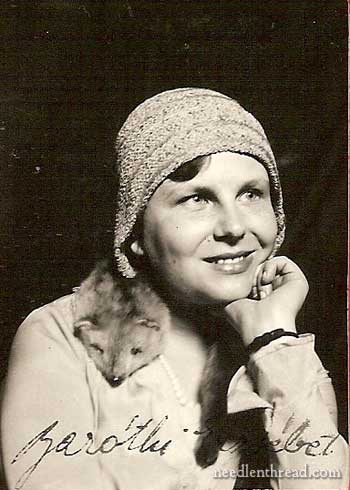
In Budapest Hungary during the period from 1932 to 1946, Lilly Barothi was busy creating needlework designs. An affluent woman, her lifestyle afforded her the opportunity to become a designer of embroidery for table dressings and dresser scarves. Fortunately, these exceptional designs were preserved by her family and a small collection of them ended up with her descendants in Canada where they fell into the life of an embroidery professional. Believing these designs lent themselves to my appliqué work, they were given to me to interpret.

As a historian, I could not help thinking about Lilly in her Budapest home during WWII, delicately drafting designs with pen and color. She escaped the Siege of Budapest in 1944, a 50-day offensive by the Soviet Army, and the ultimate surrender of the city to the Allies in 1945. She and her children had already fled to a refugee camp in Reggio Emilia, Italy where her youngest daughter died. She returned to Hungary in 1947 and divorced her husband after he escaped to Canada. She practiced her creativity in tumultuous times and it is likely that her artistic abilities saved her from utter desperation. In looking at her life I understand how charmed my own has been.
I reviewed about 10 of her designs and chose the only one that was non-symmetrical. I later learned she was a young 20 years old when it was completed. It is an original ink and watercolor graphic and beautifully done on December 7, 1932.

I was in love with it and set to work to make patterns from the original design. I settled on felted wool from Weeks Dye Works, matching threads from Bella Lusso, companion silks from Splendor by Rainbow Gallery and matching seed beads from Mill Hill.

I decided to add the appliqué shapes first and add chain stitching afterwards to connect them. By working in this order I would be able to add something of a sepal to the base of all those pointy leaves as I was chain stitching. This strategy worked out beautifully. I left the bottoms of the leaves unstitched so I could completely cover them with a lazy daisy stitch as I worked the chain stitch stems using 2 lengths of wool thread.

I carefully pinned and basted the leaves in place and appliquéd them using the slanted needle stitch. This particular design looked so good with the added dimension, like a quilt using a feathered design. The original pattern was fairly small as it was intended for embroidery. I enlarged the diameter to 17 inches to make the appliqué do-able. I also realized that I would make some changes to the color and the flower interiors as some of the shapes were very tiny. I also made changes to my basting strategies when working with some of the tinier pieces.

I didn't want to stress the small pieces by needling them too much so I carefully basted them on the outside of the piece . As I worked the appliqué stitches, I would cut away the basting or stitch around them. In working with such small pieces I cut away basting threads close to the applique surface and some basting stitches actually stayed inside and on the back. Who cares as long as they don't show, right? The last thing you want is to yank a basting stitch and pucker your appliqué ... oh yes, I've done it all.

I used silk thread to outline the flower petal shapes and added colonial knots using 4 lengths of silk. Seed beads were added carefully and sparingly to the inside edge of the flower petals adding a little shimmer without taking away from the vintage look of the piece. I used 12 strands of silk for the colonial knots on the leaves and nested a single chartreuse bead on top giving them added dimension.

The finish was another consideration. As a maker of penny rugs, I did consider them for a nano second ... but they are utterly American. I finally decided to add a crochet scalloped border in a matching Perle cotton. Although I had not actually done any crochet since I was a child, I bought a crochet hook, watched a YouTube video and voila ... the border was hatched.

As a designer myself who started out in the business with a ruling pen and watercolors, I have a great respect for Lilly's design sense and amazing execution. I admire her as being one of the women who was in this business before me and practiced her creativity through extremely challenging times in history. One can never work in tandem with another person without knowing them a little. I have now worked with Lilly interpreting her beautiful design and I am grateful to have known her ... if even just a bit.
Many thanks and big hugs to my friends Mike Parr and Guy Brassard for sharing this design with me and providing me with this adventure ... I now have a great interest in visiting Budapest!

